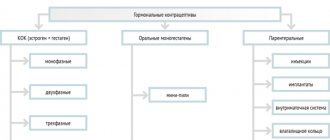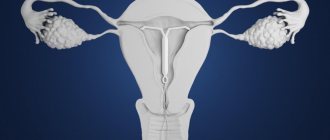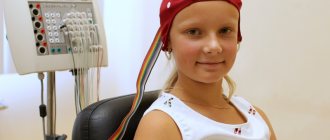The puberty period (puberty) includes a series of stages of development of the body during which a girl’s puberty occurs and her reproductive function becomes established. This process is accompanied by marker neuroendocrine and physiological changes in the reproductive system and culminates during the development of secondary sexual characteristics, the ability to ovulate and menstruate, and achieve fertility.
- Formation of secondary sexual characteristics
- Telarche
- Pubarhe
- Menarche
- Disorder of pubertal development
- Menstrual cycle
Significant growth spurts as well as dramatic psychosocial changes also characterize pubertal development. But changes in growth and psychosocial development are not always synchronous with changes in the reproductive system, which leads to an incorrect interpretation of individual “maturity.” Girls go through puberty faster than boys. Thus, girls complete pubertal development in 3 years, while boys - in 5 years.
Formation of secondary sexual characteristics
Towards the beginning of phenotypic changes in connection with the regeneration of the reticular zone of the adrenal cortex, adrenarche occurs (at 6-8 years). Gonadarche (around 8 years of age) occurs with the onset of stimulation by gonadotropin-releasing hormone (GnRH) of the anterior pituitary gland to secrete luteinizing hormone (LH) and follicle-stimulating hormone (FSH). This in turn triggers the onset of subsequent physical changes, including breast development (thelarche), development of pubic and axillary hair (pubarche), growth spurt, and onset of menstruation (menarche), usually in that order. Adrenarche and gonadarche are not parts of pubertal development.
Hormonal changes before puberty - adrenarche and gonadarche
Adrenarche - an increase in the production of androgens by the adrenal glands - occurs between the 6th and 8th years of life. In the adrenal glands, regeneration of the zona reticularis, which was suppressed immediately after the birth of the girl, begins, with a concomitant increase in the activity of P450 microsomal enzymes. This inner layer of the adrenal cortex is responsible for the secretion of sex steroid hormones. As a result, the production of androgenic steroid hormones of the adrenal glands - dehydroepiandrosterone sulfate (DHEAS), dehydroepiandrosterone (DHEA) and androstenedione - increases, which occurs from 6-8 to 13-15 years.
Gonadarche - the establishment of normal ovarian function - begins around 8 years of age, when pulsatile secretion of GnRH by the hypothalamus increases. This leads to stimulation of the synthesis of gonadotropins FSH and LH by the anterior pituitary gland, occurs mainly during sleep and is not accompanied by any phenotypic changes.
The first sign of puberty is an increase in pulsatile LH secretion at night. This pulsatile secretion of LH at night is reversed by pulsatile secretion of LH and FSH during the day, which leads to an increase in estrogen levels due to the growth of follicles in the ovaries. Positive feedback from the increase in estradiol levels initiates the LH surge necessary to induce ovulation.
Adrenarche is not necessary for normal ovarian function - gonadarche. This is confirmed by the fact that patients with hypofunction of the adrenal cortex have normal pubertal development. The ovaries, in turn, can begin to function before adrenarche in case of premature pubertal development. On the other hand, gonadal function is not necessary for adrenal function, as evidenced by normal adrenarche in patients with gonadal dysgenesis.
The first phenotypic change during puberty in most cases is the onset of mammary gland development (thelarche), which occurs around 10 years of age. But sometimes there may be an increase in the rate of linear growth 1-2 years before the onset of thelarche, signaling the onset of pubertal development.
After thelarche, pubic hair growth, pubarche, begins to develop (often together with axillary hair), which occurs around 11 years of age. Further events are usually the pubertal growth spurt (9 cm/year), which occurs around age 12, and finally menarche around age 13. Menarche usually occurs 2-2.5 years after thelarche. Normal pubertal development begins within 2.5 standard deviations from the mean, i.e. between 8 and 14 years.
Are girls' teenage years getting longer?
To make sure whether there has really been an increase in the duration of adolescence, let's consider the most convenient indicators from this point of view: the onset of menstruation and marriage. Both indicators can be tracked and marked with reasonable accuracy.
For most women, the first appearance of menstruation is an important event, and its date is recorded in the medical record. Western scientists have been tracking the average age of first menstruation since around 1840, so they have a good idea of how the onset of puberty has changed since then.
The age at marriage is usually even more carefully documented than menarche, so that we have accurate statistics on this indicator for several centuries.
In the mid-19th century, adolescence lasted approximately five years: that's how long it was in the mid-1800s. took place between the onset of menstruation in girls and marriage. At the turn of the twentieth century, on average, girls first menstruated at the age of 14–15 years, and they got married after 22 years. In the 1900s adolescence lasted just under seven years.
In the first half of the twentieth century, young people began to marry at an earlier age, however, the beginning of the puberty period also shifted towards a decrease. Because of this, the length of adolescence has remained the same: about seven years.
In 1950, for example, girls' first periods began on average at 13.5 years old, and they got married at about the age of twenty. However, since the 1950s. the situation began to change. The decline in the age of onset of puberty continued, but people began to marry later and later. Every ten years, the average age at first menstruation fell by about three to four months, while the average age at marriage increased by a year. By 2010, the average difference between the start of menstruation and marriage for girls was 15 years.
If this trend continues (and for reasons I'll explain later, it should), by 2021 it will take an average of 20 years from the start to the end of adolescence.
Telarche
The first stage of thelarche is the development of the mammary gland buds, usually occurring around 10-11 years of age. Thelarche is usually the first phenotypic change in a series of events during puberty and occurs due to an increase in circulating estrogen levels. Simultaneously with thelarche, estrogenization of the vaginal mucosa and development of the vagina and uterus occur. Further development of the mammary glands occurs during puberty and adolescence. Corresponding changes in the mammary glands are divided into 5 stages, according to the classification of Marshall and Tanner.
Pubarhe
The onset of pubic hair growth usually occurs after thelarche, around 11–12 years of age, and is often accompanied by axillary hair growth. Pubarche usually occurs after thelarche, but simultaneous development of thelarche and pubarche is also normal. In representatives of the black race, pubarche may precede thelarche, which is not a pathology.
The development of pubic and axillary hair occurs secondary to an increase in the concentration of circulating androgens. Sometimes the concepts of pubarche and adrenarche are used as synonyms, but this is not entirely true. Pubarche is the development of pubic hair, which occurs under the influence of adrenal androgens after the age of 10 years in the stage of pubertal development, and adrenarche is the activation of androgen synthesis in the adrenal glands, which occurs between the 6th and 8th years of life and precedes the onset of pubertal development.
Pubertal growth spurt
Increased estrogen secretion stimulates the production of growth hormone, which in turn stimulates insulin-like growth factor I, which promotes increased somatic growth. The pubertal growth spurt is characterized by an acceleration of the girl's growth, begins at the age of 9-10 years and reaches a maximum speed between 12 and 13 years (9 cm / year).
But this relationship is dose-dependent, and excessive estrogen levels lead to inhibition of the release of growth hormone and somatomedin-C. Subsequently, as a result of the influence of estrogens on the cessation of growth of the epiphyseal growth zones of long tubular bones, growth cessation may occur after a rapid growth spurt.
Estrogens enhance the growth of bones, especially the axial skeleton. Growth hormone has a greater effect on the growth of long bones. This explains the fact that patients with hypogonadism often have a short torso with relatively long limbs (eunuchoid habitus). With growth hormone deficiency, patients often have an appearance opposite to their genetic sex. Estrogens also promote the closure of the epiphyseal growth zones of long bones. So, patients with precocious puberty have an early onset of growth, but ultimately have short stature due to premature closure of the epiphyseal growth plates if timely treatment is not carried out.
Why does puberty begin earlier in children?
It was generally accepted that the timing of a person's puberty was determined by his genetic code: a child of parents with early puberty would most likely inherit this developmental feature. However, today it is known that the age of puberty is determined not only by genetic factors, but also by environmental influences.
The most important elements of this influence are health and nutrition. On average, children whose mothers were well-nourished and healthy during pregnancy, and who grew up healthy and well-nourished themselves, are more likely to have an early onset of puberty. Significant decline in the onset of puberty between 1850 and 1950s. can be attributed mainly to improved child and maternal health.
Menarche
The average age of menarche (first menstruation) ranges between 12 and 13 years (12.7 years). Menarche usually occurs 2 years after thelarche (development of the mammary gland buds). The menstrual cycle in adolescents is usually irregular during the first 6 months to 1 year after menarche, indicating anovulatory cycles. The establishment of regular ovulatory cycles begins approximately 2 years after menarche.
Delayed menarche can occur in gymnasts, long-distance runners and ballerinas. It has been suggested that the signal for the onset of menarche is the achievement of a certain body weight (17-22% body fat), usually occurring at body weight > 45 kg. But there is no exact data on what affects the delay of menarche more: lack of adipose tissue or stress and physical activity.
Ovulatory menstrual cycles are accompanied by an increase in progesterone levels after ovulation. Ovulation is usually inconsistent for 1-2 years after menarche, resulting in irregular menstrual cycles. After this period, the menstrual cycle in adolescents should become established, and the absence of regular cycles may indicate reproductive disorders.
Weight change
Sports for teenagers
Physical activity is extremely important during adolescence. How to choose a sport for a teenager, says Alexey Korochkin, researcher at the Department of Exercise Therapy and Sports Medicine of the Russian State Medical University.
During puberty, girls begin to actively form adipose tissue in the body, mainly on the hips and buttocks. Boys also begin to deposit fat, but outwardly this is not so noticeable, since in parallel there is an increased growth of muscle tissue. By the end of puberty, its mass in a male teenager becomes one and a half times greater than in a girl of the same height and weight.
Disorder of pubertal development
Normal pubertal development begins between 8 and 14 years of age (±2.5 standard deviations from the mean). If a girl develops secondary sexual characteristics at age 8, or if secondary sexual characteristics are absent before age 14, or if a girl with developed secondary sexual characteristics does not menstruate before age 16, such patients are subject to additional examination.
For representatives of the black race, puberty can normally begin before the age of 8 years. Isolated premature thelarche or pubarche without other signs of pubertal development may occur, does not require urgent examination, but indicates the need for observation to exclude possible premature pubertal development. Premature thelarche usually occurs in the first 7 years of life, and premature pubarche may be an early sign of polycystic ovary syndrome later in life. Precocious pubertal development is more common in girls (5 times more common than in boys), and delayed pubertal development is more common in boys.
Pubertal development may begin earlier due to the following circumstances:
- in patients with a family history of early pubertal development;
- among representatives of the black race; when living in the equatorial zone;
- when living low relative to sea level; in urbanized cities;
- for obesity;
- in case of blindness.
Late onset of puberty can be observed:
1) with diabetes mellitus;
2) with significant degrees of obesity;
3) with insufficient nutrition;
4) with excessive stress and physical activity.
How to determine the onset of adolescence
Determining the beginning and end of this age is traditionally subjective. As a rule, experts correlate its onset with the onset of puberty, since it is easy to establish; it has an obvious outcome (puberty), and this biological process is universal. In societies where rites of passage have been adopted, puberty has long been used as an indicator of the end of childhood.
Although there is no formal initiation ceremony in modern society, we still continue to consider puberty as the transition into adolescence. Coming to a consensus on when adolescence ends is somewhat more difficult.
Although there are objective biological differences between adolescence and adulthood (for example, the point at which a person stops growing or being able to bear children), they can hardly be taken as a criterion. For some people, the growth phase ends at 12–13 years old, while others can even physically become parents at this age. That said, few of us, at least in modern society, are willing to call a 13-year-old an “adult.”
Therefore, social indicators such as reaching adulthood, working full-time, or living separately from parents are often used to define the boundary between adolescence and adulthood. That's why experts say that adolescence begins with biology and ends with sociology.
Premature pubertal development
Premature puberty is the appearance of secondary sexual characteristics before the age of 8 years. In girls, about 75% of precocious pubertal development is idiopathic, while in boys it is only 40%. Modern capabilities of highly sensitive methods of intracranial imaging, in particular magnetic resonance imaging, may make it possible to identify the causes of these so-called “idiopathic” conditions.
Isosexual precocious puberty is a precocious puberty that corresponds to an individual's genetic sex.
Heterosexual precocious puberty is precocious puberty that develops in a pattern opposite to the individual's genetic sex. Heterosexual precocious pubertal development in girls reflects excessive androgen production by the adrenal glands or ovaries. Isosexual precocious development is more common than heterosexual precocious development.
There are two forms of premature sexual development : GnRH-dependent and GnRH-independent. GnRH-dependent form of precocious puberty (“true”, “complete”, “central”) develops due to premature activation of the hypothalamic-pituitary-gonadal axis, namely with early activation of the hypothalamic generator of GnRH pulsations, and is usually idiopathic.
Treatment of this condition involves the administration of gonadotropin-releasing hormone agonists (zoladex, diferelin, lupron) to suppress the premature activation of the GnRH pulsatility. One of the most serious causes of GnRH-dependent premature pubertal development are tumors of the central nervous system), in particular hamartomas. Treatment of hamartros can be surgical, radiation or medication (GnRH agonists).
GnRH-independent form of precocious sexual development (incomplete, peripheral, premature pseudopubertal development) develops due to the production of sex steroids by the ovaries, which does not depend on hypothalamic-pituitary-gonadal regulation. In some cases, peripheral hormone production can activate the hypothalamic-pituitary-gonadal axis, leading to a mixed form of precocious puberty.
The most common causes of GnRH-independent precocious puberty may be the following conditions:
- functional ovarian cysts (most common cause);
- granulosa cell tumors of the ovaries (subject to surgical removal);
- McCune-Albright syndrome is a polycystic fibrous dysplasia characterized by numerous fibrocystic bone lesions, asymmetric skin pigmentation (“coffee spots”) and precocious puberty;
- autonomous production of estrogen by the ovaries due to genetic mutations of gonadotropin receptors, which leads to their activation and premature sexual development; Treatment of this syndrome consists of prescribing an aromatase inhibitor - testolactone;
- hypothyroidism (there is a delay in bone age, in contrast to advance in all other forms, hormone replacement therapy with thyroxine is used);
- exogenous hormonal drug therapy (it is necessary to discontinue such therapy);
- steroid-producing adrenal tumors (rare, subject to surgical removal).
Diagnosis of precocious puberty and its forms begins by collecting the patient’s medical history. They find out the characteristics of the child’s growth, the peculiarities of the appearance of signs of puberty, family history regarding possible reproductive anomalies, the presence of exogenous hormonal effects, symptoms of thyroid diseases, neurological and cerebrovascular diseases (stroke).
An objective examination evaluates height, body weight relative to age standards, and weight-height ratio. The severity of secondary sexual characteristics is assessed using the Tanner scale, studies of the thyroid gland and neurological status are performed, the skin is examined for the presence of “coffee spots”, ultrasonography, abdominal and pelvic (vaginal or rectal) examination is performed to identify functional cysts and ovarian tumors.
Laboratory tests include assessment of serum levels of estradiol, LH, FSH, TSH (TSH), and human chorionic gonadotropin (hCG). In the case of heterosexual puberty, the levels of DHEAS, 17-hydroxyprogesterone and testosterone are assessed.
The most important radiological test is bone age assessment (in the bones of the left wrist) to assess skeletal maturity. Bone age was increased in all forms of premature puberty, with the exception of primary hypothyroidism (delayed bone age).
Ultrasonography is used to evaluate the pelvic organs (functional cysts, ovarian tumors) and abdominal cavity; if a tumor of the adrenal glands or central nervous system is suspected - computed tomography (CT) or magnetic resonance imaging (MRI), if McCune-Albright syndrome is suspected - bone x-ray.
Delayed pubertal development
Delayed pubertal development is the absence of development of secondary sexual characteristics before age 14 or absence of menarche before age 16. Failure to menarche before age 16 is called primary amenorrhea.
Patients with delayed sexual development and primary amenorrhea are classified according to the presence or absence of mammary gland development (a sign of the presence of estrogen production), as well as the presence or absence of the uterus:
1. The uterus is absent in the case of production of Müllerian inhibitory factor (anti-Müllerian hormone) by testicular tissue. In this case, the karyotype and testosterone level are determined for the differential diagnosis of agenesis of the uterus and vagina (primary amenorrhea in the presence of secondary sexual characteristics in Mayer-Rokitansky-Küster-Gauser syndrome) and congenital insensitivity to the action of androgens (testicular feminization syndrome).
2. If breast development is absent, the FSH level is assessed, which makes it possible to identify ovarian insufficiency (high FSH) or hypothalamic-pituitary insufficiency (low FSH).
3. Cases of absence of the uterus and lack of development of the mammary glands are extremely rare.
4. In the presence of a uterus and the development of mammary glands, the management of patients is similar to that for secondary amenorrhea.
The most common cause of primary amenorrhea and delayed sexual development is gonadal dysgenesis (Turner, Shereshevsky-Turner syndromes). In second place in frequency is agenesis of the uterus and vagina (primary amenorrhea in the presence of secondary sexual characteristics in Mayer-Rokitansky-Küster-Gauser syndrome), in third place is insensitivity to the action of androgens (testicular feminization syndrome).
Menstrual cycle
The hypothalamus, pituitary gland, ovaries and uterus are components of the female reproductive system that take part in the establishment and regulation of the menstrual cycle and function through positive and negative forward and feedback connections. In a genetic female fetus, at the 20th week of development, the ovaries contain 6-7 million germ cells, the number of which decreases to 2 million at the time of birth and to 300,000 before the onset of puberty.
The menstrual cycle normally lasts 28 days (variations from 21 to 35 days). Only 15% of women have a 28-day menstrual cycle. The menstrual cycle is most irregular during the 2 years after menarche and 3 years before menopause (the last menstruation in a woman’s life). Anovulatory cycles during these periods are 6-35%.
The menstrual cycle is divided into two 14-day phases: I - follicular and II - luteal, characterized by changes in the ovaries during the cycle. These phases are also called proliferative and secretory, reflecting synchronous changes in the endometrium during the same period of time. These cyclic changes occur in the superficial, functional layer of the endometrium (both its compact and spongy layers), whereas the basal layer of the endometrium is insensitive to hormonal stimuli and remains intact throughout the menstrual cycle (regenerative zone).
During the follicular phase of the cycle, the release of FSH by the pituitary gland causes the development of primary ovarian follicles. Ovarian follicles produce estrogens, which, in turn, stimulate endometrial proliferation. Under the influence of FSH, usually only one of these follicles (dominant) reaches maximum development - the stage of a mature (tertiary, Graafian) follicle; others stop developing at different stages (primary, secondary follicles).
In the middle of the menstrual cycle, around the 14th day, in response to the achievement of the maximum concentration of estrogens synthesized by granulosa cells of the follicles, a peak in LH secretion by the pituitary gland occurs. This LH peak stimulates ovulation - the rupture of the wall of the mature follicle and the release of the egg, which almost immediately enters the lumen of the ampullary part of the fallopian tube.
After ovulation, the second, luteal phase of the menstrual cycle begins. The dominant follicle in which ovulation took place accumulates luteal pigment and develops into the corpus luteum. The corpus luteum, next to the secretion of estrogen, begins to produce progesterone, which promotes secretory changes in the endometrium (decidualization, decidual reactions - accumulation of glycogen, as well as increased vascularization) to ensure implantation of a fertilized egg.
If fertilization does not occur, the corpus luteum degenerates and progesterone (and estrogen) levels decrease. With a sharp decrease in the level of progesterone and estrogen in the endometrium, ischemia and desquamation of the epithelium of the functional layer develops - menstruation (menstrual phase).
Follicular phase
Canceling the influence of estrogen and progesterone at the end of the luteal phase of the previous menstrual cycle leads to a gradual increase in the release of FSH by the pituitary gland. In turn, FSH stimulates the growth of 5 to 15 primordial follicles (eggs, the development of which is stopped at the diplotene stage in the prophase of the first meiotic division, surrounded by a single layer of granulosa cells), which means the beginning of the first, follicular, phase of the new menstrual cycle. The development of primordial (primary) follicles to the Diploten stage of prophase of the first meiotic division does not depend on the action of gonadotropins.
Of these primordial follicles, usually only 1 becomes dominant and matures into a preantral, secondary follicle (an oocyte surrounded by the zona pellucida with several layers of granulosa and theca cells). The development of preantral follicles is gonadotropin dependent.
Selection of the dominant follicle occurs on days 5-7 of the menstrual cycle. The preantral follicle secretes estrogens, accumulates follicular fluid and matures to the stage of ovulatory (tertiary, Graafian) follicle. FSH is responsible for inducing the synthesis of LH receptors and the aromatase enzyme, which is responsible for the conversion of androgens to estrogens in the growing follicle. Estrogens act synergistically with FSH and increase the number of FSH receptors in granulosa cells of the follicle, as well as their mitotic activity.
The follicle develops and reaches preovulatory maturity through the production of estrogens, which enhance its maturation and also stimulate the formation of FSH and LH receptors in an autocrine manner. Estrogens are produced by the “two-cell”, “dagonadotropin pathway”. The cells of the inner theca membrane of the follicle (papa cells) produce androstenedione in response to LH stimulation, and the granulosa cells of the follicle, under the influence of FSH and with the help of the aromatase enzyme, convert this androstenedione into estradiol.
The synthesis of androgens, which are also converted into estrogens, stimulates LH. Androgens promote atresia of non-dominant follicles. Androgens in high concentrations are subject to 5a-reduction into more active androgens. A premature increase in LH secretion also reduces the mitotic activity of granulosa cells and contributes to degenerative changes in the follicles.
An increase in the level of circulating estrogens, according to the law of central negative feedback, affects the secretion of FSH by the pituitary gland. This leads to the withdrawal of gonadotropins supporting other developing follicles. The dominant follicle is protected from a decrease in FSH levels due to the increased concentration of FSH receptors in it. In addition, increased vascularization of the inner layer of theca cells also contributes to greater sensitivity of the dominant follicle to the action of FSH. By suppressing the secretion of gonadotropins by increasing its own estrogen production, the dominant follicle optimizes its own development by stopping the growth of other follicles.
Ovulation
At the end of the follicular phase, estrogen levels increase significantly and reach a critical (peak) value (> 200 pg/ml), which is observed for about 50 hours, which is a trigger for the anterior pituitary gland to release the maximum amount of LH. This positive feedback between rising estrogen levels and rising LH concentrations is enhanced by low progesterone levels.
Ovulation occurs due to LH-induced rupture of the follicle and release of a mature egg approximately 34-36 hours after the onset of the LH rise or 10-12 hours after the LH peak. The LH surge initiates the resumption of meiosis in the oocyte, causes luteinization of the granulosa cells of the follicle and stimulates the synthesis of prostaglandins and progesterone necessary for follicle rupture. Degenerative changes in the follicle wall can develop due to the destruction of collagen, which leads to both passive reduction and rupture of the follicle. Prostaglandins and lysosomal enzymes (proteases) cause degenerative changes in the follicle wall.
Ovulation is accompanied by the completion of the first meiotic division with the release of the first polar body. The egg usually enters the fallopian tube and, thanks to the movement of the cilia of its epithelium, moves into the uterus. This process usually lasts 3 to 4 days. If fertilization of the egg does not occur within 24 hours after ovulation, it degenerates.
Luteal phase
After ovulation, the luteal phase of the cycle begins. Granulosa cells and the inner thecal membrane of the follicle line its wall and, under the influence of LH, form the corpus luteum. Life expectancy and steroidogenic activity of the corpus luteum depend on prolonged tonic LH secretion, which leads to an increase in the secretion of progesterone by the corpus luteum. Normal function of the corpus luteum requires optimal preovulatory development of the follicle (i.e., adequate FSH stimulation) and constant tonic LH support.
The corpus luteum synthesizes estrogens and a significant amount of progesterone, causes further development of glands and secretory changes in the endometrium (vascularization, accumulation of glycogen), which are preparatory processes for implantation of a fertilized egg. The peak secretion of progesterone by the corpus luteum occurs around the 8th day after the LH peak, which affects the maturation of the secretory endometrium and suppresses follicular growth.
Each day of the luteal phase is accompanied by certain microscopic changes in the glands and stroma of the endometrium. Implantation usually occurs on days 22-23 of the menstrual cycle, coinciding with the maximum intracellular apocrine secretory activity of endometrial cells.
If fertilization occurs, the developing trophoblast begins to synthesize human chorionic gonadotropin (hCG), a glycoprotein similar to LH, which provides support for the function of the corpus luteum (development of the corpus luteum of pregnancy), i.e. stimulates the secretion of estrogen and progesterone, which is necessary to maintain the endometrium until the development of the placenta and the beginning of its hormone-producing function (8-10 weeks of gestation). Insufficient function of the corpus luteum causes the so-called luteal phase defect of the cycle (luteal phase insufficiency), which is considered one of the possible causes of abortion at an early stage.
If fertilization, and therefore the synthesis of hCG caused by it, does not occur, the corpus luteum degenerates (corpus luteum of menstruation), the level of progesterone and estrogen decreases, hormonal support of the endometrium does not occur, ischemic changes develop in it and menstruation occurs - rejection of the functional layer of the endometrium.
The child's body differs from the adult's body in rapid growth and development. Among the stages of ontogenesis, the most important are intrauterine development and childhood. The process of formation of the sexual phenotype in a child occurs throughout the entire period of growth and maturation of the body, but the most significant in this regard are the period of sex formation in the fetus, which takes about 4 months, and adolescence. Puberty is an extremely complex process with significant changes in physical and neuropsychological development.
We often observe how a talkative, sincere and open child suddenly becomes harsh, irritable, and sometimes rude. This usually happens with 10-15 year old children. Not only their behavior changes, but also their appearance. They quickly stretch out, lose weight, become clumsy, and sometimes acne appears on their face. It is with children of this age that parents turn to a pediatrician about dizziness, fainting, and pain in the heart. In certain situations – and to a neuropsychiatrist.
What's wrong with the child - parents are perplexed: is the company influencing him, is he not getting enough sleep, is he getting little rest, is he sick? The child himself cannot understand the “new” that so suddenly washed over him. What happens in the body during adolescence? How to help a child cope with emerging difficulties and problems?
During adolescence, the transition from childhood to adolescence occurs. It is characterized by changes in both physical and neuropsychic development. During this period, a sharp hormonal change in the body occurs: the activity of the endocrine glands - the pituitary gland, adrenal glands, thyroid gland - increases, and the sex glands begin to function intensively.
For a girl, this is the time when she ceases to be a girl and begins to turn into a woman. Everyone goes through puberty, although not at the same time. This is an integral part of the growing process. Puberty brings physical, mental and emotional changes. The girl’s body becomes stronger and more developed, and her thoughts and feelings also change. There may be sudden mood swings. Today you can consider yourself the happiest person in the world, and tomorrow you can feel the most unhappy. During puberty, such sensations are normal.
The period of puberty is individual for each girl. For most girls, it occurs between the ages of 8 and 13 years. For some it comes a little earlier, for others a little later. Moreover, during puberty, changes occur not only in the genitals. The whole body is being rebuilt. It develops intensively, internal organs work intensively, the activity of the nervous system is restructured, and the psyche changes.
The period of puberty is a relatively long period of qualitative growth of a child’s body, its transition to a mature one. This development occurs unevenly, some processes are ahead of others, the harmony in the external appearance of the teenager, in the activity of his internal organs, in his mood, and behavior is temporarily disturbed. The growth of the limbs outpaces the growth of the body, movements become angular and awkward. This happens due to a lack of coordination on the part of the central nervous system. Along with this, muscle strength increases, especially towards the end of puberty. The intensive growth of the bone skeleton and muscular system is not always kept up with the development of internal organs - the heart, lungs, and gastrointestinal tract. The heart outpaces the blood vessels in growth, as a result of which blood pressure rises and, first of all, complicates the work of the heart itself. At the same time, the rapid restructuring of the entire body, in turn, places increased demands on the heart. And insufficient heart function leads to dizziness, blueness and coldness of the extremities. Hence the headaches, fatigue, periodic bouts of lethargy, and fainting due to spasm of cerebral vessels. With the end of puberty, these disorders usually disappear without a trace.
Intensive growth, a sharp increase in the activity of the endocrine glands, structural and physiological changes in the body significantly increase the excitability of the central nervous system and change the psyche of a teenager. This explains the oddities in behavior: apathy and an indifferent attitude to what is happening are suddenly replaced by very violent and energetic reactions to trifles. Emotions are mobile, changeable, contradictory: increased sensitivity is often combined with callousness, shyness with swagger. Sometimes there is a decrease in performance, neurotic reactions, irritability, and tearfulness.
New relationships between the sexes are emerging. Girls are becoming increasingly interested in their appearance. Boys strive to show their strength to girls.
Puberty begins when a gland called the pituitary gland sends a signal to the ovaries to begin producing a certain chemical. This compound is a hormone and is called “estrogen”. Estrogen causes many of the changes that occur in a girl's body during puberty.
For most girls, the first sign of puberty is a sharp increase in height. In less than a year, a girl can grow by about 7-8 cm. At 10-11 years old, the mammary glands begin to enlarge. The breasts become larger and fuller. Some girls' breasts begin to grow earlier than others. Some will have larger breasts, while others will have small breasts. Other physical changes are also noticeable during puberty. At the age of 11-12 years, pubic hair begins to grow. Hair also begins to grow under the arms and on the legs. The body takes on a softer and more rounded shape. The waist may decrease, and the hips will increase slightly. The girl may notice that spots of white, yellowish or colorless liquid appear on her underwear. Light-colored discharge is absolutely normal and indicates that the girl will soon begin regular menstruation. After the onset of such menstruation, the appearance of natural discharge throughout adult life is absolutely normal. If the discharge is causing you concern, you should definitely consult a doctor.
One of the most significant events during puberty is the onset of menstruation. This is a completely normal process and not dangerous to health. The onset of menstruation is considered timely no earlier than 10 years and no later than 15.
The appearance of the first menstruation only indicates the beginning of puberty. And although a girl can already become pregnant, the genitals and the entire body are not yet mature for sexual activity. The development of the female body ends by the age of 20-23.
What is menstruation? Menstruation is part of a regular process that occurs in the body of a girl (woman) and ends the cycle of preparing the female body for a possible pregnancy. In fact, within a few days, the inner lining of the uterine cavity (endometrium), which is not needed for the development of pregnancy, is rejected, with the formation of a blood-like fluid that is released from the uterus, and then through the vagina - and from the girl’s (woman’s) body. Taken together, all these phenomena are called the menstrual cycle.
The menstrual cycle begins from the first day of menstruation until the first day of the next menstruation. The duration of menstruation is from three to eight days. It's different for every girl. As a rule, there is more discharge at the beginning of menstruation, and less at the end. During the entire period of menstruation, a girl loses about 100 - 120 ml of blood. If menstruation is established, then it repeats every month after 21–35 days. A cycle is considered regular when menstruation appears at regular intervals, lasts the same number of days and with the same intensity.
At the beginning (about 1 - 1.5 years), menstruation is often irregular: it lasts 7 - 8 days, then disappears for several months. Nervous shock and severe physical pain can accelerate the onset of menstruation. Often the menstrual cycle is disrupted when moving from the lowlands to the mountains, from north to south. Exhaustive long-term work, severe overwork, sudden weight loss can cause the cessation of menstruation. The first menstruation is sometimes accompanied by poor general condition, weakness, pain or significant blood loss. Sometimes there may be a slight increase in temperature, diarrhea or constipation, and dizziness.
Some girls experience discomfort during menstruation, which is called menstrual pain. The pain can be dull, aching, cramping, and often a slight intensity is observed even before the onset of menstruation. They are felt in the lower abdomen, in the lower back, in the sacrum, and sometimes spread to the hips. The pain can be combined with nausea, vomiting, headache, and gastrointestinal upset. The causes of pain are varied. They can appear as a result of changes in the genital organs (inflammation, underdevelopment, abnormal position of the uterus), due to some chronic somatic and nervous diseases. In girls, painful menstruation is most often caused by some underdevelopment of the uterus. A small uterus with an inferior muscular layer, with a sharp bend anteriorly or posteriorly, an elongated and narrow cervix is filled with menstrual blood. To expel it, the uterus begins to contract strongly, which is accompanied by pain, sometimes excessively severe, with loss of ability to work. Treatment is usually aimed at eliminating the cause of the pain. A calm lifestyle and moderate exercise, which strengthen the nervous system and thereby help relieve menstrual pain, are essential. If menstruation is very painful and heavy, you should consult a doctor.
To control the quality of menstrual function, a girl needs to mark the beginning, end and duration of each menstruation on a calendar - keep a menstrual calendar.
If you feel well during menstruation, you can lead a normal lifestyle, continue to do morning exercises, and simple physical exercises. During this time, exercises involving jumping, cycling, and heavy lifting are prohibited. It is not recommended to skate, ski, take long walks, take a bath, or swim in the river or sea.
Strongly stimulating substances such as vinegar, mustard, pepper, horseradish, coffee, strong tea, and chocolate should be excluded from the diet during menstruation. Beer, wine and other alcoholic beverages should not be consumed, as due to increased blood flow this can lead to menstrual bleeding.
Particular attention should be paid to the timely emptying of the bladder and intestines, since their overflow leads to displacement of the uterus, which can additionally cause pain.
A girl should especially carefully monitor the cleanliness of her body during menstruation, since the inner surface of the uterine cavity bleeds during this period and turns into a wound surface, where, under favorable conditions, microbes can find an excellent nutrient medium. Therefore, during menstruation, it is important to change your underwear frequently, use sanitary pads and change them in a timely manner, be sure to wash yourself with warm boiled water at least 2 times a day, and take a shower.
How often should gaskets be changed? At the beginning of menstruation, when the discharge is usually heavier, you need to change the pad every 2-3 hours. Towards the end of menstruation, when the discharge usually decreases, the pads can be changed every 4-6 hours. You cannot use the same pad for more than 6 hours. With prolonged contact with air, menstrual blood becomes infected and begins to emit an odor. Therefore, it is necessary to change the gaskets regularly.
You should also take a bath or shower regularly because the sebaceous glands, especially on the face and chest, work more actively during puberty. The sebaceous glands secrete a fatty substance called sebum. If this oil clogs the pores of the skin and comes into contact with bacteria, acne may appear on the skin. For many, such acne is a characteristic sign of puberty (adolescent acne). Be sure to wash your face at least twice a day. Do not touch your face with unwashed hands or squeeze out acne. Otherwise, you can get infected and leave scars on your face. If normal hygiene measures do not help, then you can try lotion or cleansing wipes or anti-acne cream. If this does not help, you need to consult a cosmetologist or dermatologist.
Despite all the complex changes occurring in the body, the teenage girl is young and beautiful, and the world around her is huge and amazing. Parents and close people should help the girl feel the wonderful power in herself - the power of girlish charm, feel her transformation into a beautiful woman. Your daughter is already an adult and can decide for herself whether she needs to improve her appearance and her inner world. Just a year or two ago she was a girl, and now she is becoming a girl. These changes should make her proud: after all, what nature gave the girl is wonderful, all this will allow her to become a beloved wife and a happy mother over time.










